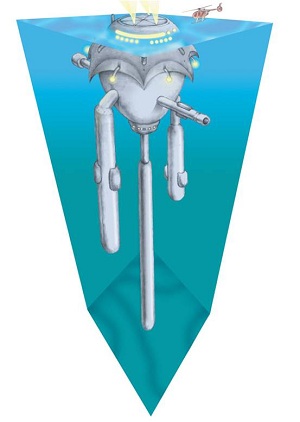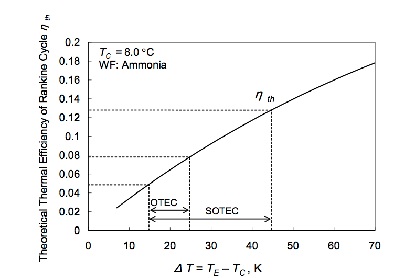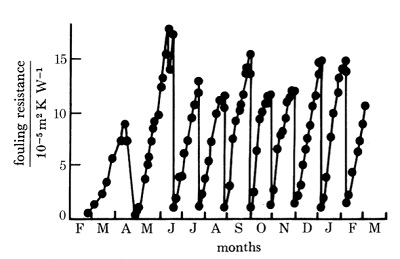
 D'Arsonval
D'Arsonval
|
Ocean Thermal Energy Conversion was originally the idea of a French physicsist, Jacues Arsene D�Arsonval, who first proposed harnessing the oceans thermal energy to produce electricity in 1881. It was a student of his, Georges Claude, that built the first working OTEC plant in 1930. Since then much research has gone into making OTEC a feasible form of renewable energy. |
 Georges Claude
Georges Claude
|

|
OTEC power plants use the temperature difference of ocean water to drive a heat engine, whose ideal thermal efficiency is a function only of that temperature difference. Since maximum temperature differences of around 25� C can be harnessed, these plants inherently have very poor efficiencies. The advancement of this technology continued despite this, driven by the many advantages this form of energy generation promised. OTEC is an extremely clean and sustainable technology and in some cases will even produce desalinized water as a byproduct. Like any alternative form of energy generation OTEC has its advantages and disadvantages, but it nonetheless a feasible means to achieve a future of sustainable power. Wherever there'a gradient in temperature, there exists an opportunity to use this gradient to do work and create power. OTEC uses the difference between warm surface water and cold deep-sea water in a cycle to run a turbine. These power plants face many engineering challenges. They require deep-water sources so are only useful around costal regions and islands. Additionally, the pumping of ocean water from up to 1000 feet deep requires a large diameter pipeline. Dealing with ocean conditions is also often difficult in executing an OTEC power plant. The offshore location of these plants means they must be located on floating barges, fixed platforms, or deep beneath the sea. |


|
The closed cycle OTEC power plant operates in a Rankine Cycle. A working fluid with a low vapor pressure is evaporated in a heat exchanger using the warm surface water. The vapor created is used to run a turbine. A surface condenser heat exchanger then uses the cold ocean water to convert the working fluid into a liquid again so it can be pumped back into the evaporator. The closed cycle OTEC allows for higher pressure and vapor densities. This means that smaller turbines can be used then with the open cycle OTEC plants. However, the heat exchangers required are large and costly. Additionally, some working fluids can pose environmental concerns should they leak. |
|
Because of the small temperature difference between deep ocean water and surface water, it’s possible to increase the theoretical thermal energy of the Rankine cycle by heating the surface water to a higher temperature. Solar and Ocean Thermal Energy Conversion (SOTEC) does just this by passing the surface water through solar collectors. This Increases the theoretical thermal efficiency. |

|

|
Mineral deposits and micro bacterial growth often plague heat exchangers, especially when dealing with seawater. Because of this, regular cleaning of the heat exchangers and pipeline has to be done to keep the fouling factor down. See the figure to the left for an example of how fouling factor changes with time and monthly maintenance keeps it down. |
EconomicsA major consideration in power generation is the cost to build a facility and the levelized cost of electricity (COE). Unfortunately, there are not many OTEC plants deployed or built to large scale. Therefore all the financial numbers are based off predictions. This must be kept in mind when considering OTEC as a power system. Based on estimations from one of the pioneer designers of OTEC, J. Hilbert Anderson, a 100 MW barge style platform would cost roughly $250 million (2002 dollars). Estimation of a 40 MW platform with an underwater power cable to shore predicted the capital cost being $4000/kW, which is about $160 million, and that the cost to produce electricity to be about 0.10 $/kWh.
Also, when we consider a nuclear power plant f or comparison, the cost of construction is approximately $2000/kW and has a COE of 0.02-0.04 $/kWh. This makes a nuclear facility much more attractive in terms of shear cost. However, the process in which OTEC operates is essentially a desalination process. That means that most of the water that comes through the heat exchanger becomes fresh water. Therefore, if this system was to be implemented in a South Pacific island, it could prove to be invaluable. For example, the island of Nauru, and island only 8.1 square miles, has a 100 kW OTEC facility that provides power to run a school, and some other buildings. This set a world record for power generation for an OTEC facility. The major reason for the lack of OTEC platform deployment is the cost. The cost could come down drastically with more research and advancements in heat exchangers, deep water pumps, and turbines. Unfortunately, the bulk of research currently done is computer based simulations. Again, high costs are the primary reason for this. If costs were to come down marginally, or there was increased interest, then more research monies would become available and critical experiments could be done. Therefore, in order for OTEC to become a viable power generation option, the costs would need to drop drastically and become competitive of other sustainable energy options such as wind, wave, or solar. The only way for this to occur is for people to gain interest in OTEC and help further research on the critical components that drive the cost up. |
|
Although OTEC technologies seem to provide some of the cleanest and most sustainable energy generation, their poor thermal and economic efficiencies prevent them from becoming main contributors to the push for renewable energy, at least in the near future. This 120 year old concept still has much research and development to undergo before it can be seen as a viable replacement for some of the more developed forms of renewable energy such as wind and solar power. In theory, OTEC moves to the forefront as one of the best solutions for a sustainable future, but it is the reality of this technology’s efficiency and costs that prevent it from becoming a feasible large scale contributor. |
Click the links below to learn more about OTEC |
||||
| NELHA | OTEC news | OTEC Library | Sea Solar Power | OTEC at Lockheed Martin |